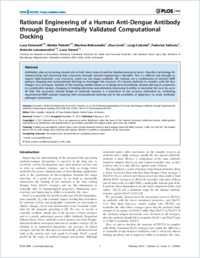Rational engineering of a human anti-dengue antibody through experimentally validated computational docking
- Simonelli, Luca Institute for Research in Biomedicine (IRB), Faculty of Biomedical Sciences, Università della Svizzera italiana, Switzerland
- Pedotti, Mattia Institute for Research in Biomedicine (IRB), Faculty of Biomedical Sciences, Università della Svizzera italiana, Switzerland
- Beltramello, Martina Institute for Research in Biomedicine (IRB), Faculty of Biomedical Sciences, Università della Svizzera italiana, Switzerland
- Livoti, Elsa Institute for Research in Biomedicine (IRB), Faculty of Biomedical Sciences, Università della Svizzera italiana, Switzerland
- Calzolai, Luigi Institute for Health and Consumer Protection, Joint Research Centre, Ispra, Italy
- Sallusto, Federica Institute for Research in Biomedicine (IRB), Faculty of Biomedical Sciences, Università della Svizzera italiana, Switzerland
- Lanzavecchia, Antonio Institute for Research in Biomedicine (IRB), Faculty of Biomedical Sciences, Università della Svizzera italiana, Switzerland - Institute of Microbiology, Eidgenössische Technische Hochschule (ETH) Zürich, Zürich, Switzerland
- Varani, Luca Institute of Microbiology, Eidgenössische Technische Hochschule (ETH) Zürich, Zürich, Switzerland
-
06.02.2013
Published in:
- Plos one. - 2013, vol. 8, no. 2, p. e55561
English
Antibodies play an increasing pivotal role in both basic research and the biopharmaceutical sector, therefore technology for characterizing and improving their properties through rational engineering is desirable. This is a difficult task thought to require high-resolution x-ray structures, which are not always available. We, instead, use a combination of solution NMR epitope mapping and computational docking to investigate the structure of a human antibody in complex with the four Dengue virus serotypes. Analysis of the resulting models allows us to design several antibody mutants altering its properties in a predictable manner, changing its binding selectivity and ultimately improving its ability to neutralize the virus by up to 40 fold. The successful rational design of antibody mutants is a testament to the accuracy achievable by combining experimental NMR epitope mapping with computational docking and to the possibility of applying it to study antibody/pathogen interactions.
- Language
-
- English
- Classification
- Medicine
- License
- Open access status
- gold
- Identifiers
-
- RERO DOC 326695
- DOI 10.1371/journal.pone.0055561
- ARK ark:/12658/srd1319180
- Persistent URL
- https://n2t.net/ark:/12658/srd1319180
Statistics
Document views: 184
File downloads:
- Texte intégral: 174
